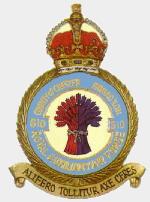Hobby Master HA7102 RAF Supermarine Spitfire Mk. XIVc Fighter - Squadron Leader Newbury, No.610 Squadron, 1944 (1:48 Scale)
"Never in the field of human conflict was so much owed by so many to so few."
- British Prime Minister Winston Churchill, commenting on the British airmen in the Battle of Britain
 The Spitfire is the most famous British aircraft of all time. Although less numerous than the Hawker Hurricane, it is remembered as the sleek, thoroughbred fighting machine that turned the tide during the Battle of Britain. The Spitfire was among the fastest and most maneuverable prop-driven fighters of World War II, serving in virtually every combat theater.
The Spitfire is the most famous British aircraft of all time. Although less numerous than the Hawker Hurricane, it is remembered as the sleek, thoroughbred fighting machine that turned the tide during the Battle of Britain. The Spitfire was among the fastest and most maneuverable prop-driven fighters of World War II, serving in virtually every combat theater.
Supermarine designer Reginald Mitchell created this small, graceful, elliptical-wing fighter with eight guns in the wings that were able to fire without being hindered by the propeller. The immortal Spitfire thus became not merely one of the best-performing fighters of all time, but also one of the best-looking. Although never employed as a long-range escort, the Spitfire was a champion in an air-to-air duel. Spitfires routinely dived at the speed of sound, faster than any of the German jets.
A carrier-based version, called the Seafire, was a winner in its own right, serving valiantly on convoy routes during World War II. The Seafire 47 was even used in the early stages of the Korean War, before it was replaced by more modern jet aircraft.
This particular 1:48 scale replica of a Supermarine Spitfire Mk. XIVc fighter was flown by Squadron Leader Newbury, of No.610 Squadron.
Sold Out!
Dimensions:
Wing Span: 9-inches
Length: 7-1/2-inches
Release Date: December 2007
 Historical Account: "Chasing Buzz Bombs" - The first Griffon powered Spitfires suffered poor high altitude performance due to having only a single stage supercharged engine. By 1943, Rolls-Royce engineers had put together a new Griffon engine, the 61 series, with a two-stage supercharger. In the end it was a slightly modified engine, the 65 series, which was used in the Mk XIV. The resulting aircraft was as great an improvement over the Mk IX as the Mk IX had been over the Mk V. Although initially based on the Mk VIII air frame, common improvements made in aircraft produced later included the cut-back fuselage and tear-drop canopies, and the E-Type wing with improved armament.
Historical Account: "Chasing Buzz Bombs" - The first Griffon powered Spitfires suffered poor high altitude performance due to having only a single stage supercharged engine. By 1943, Rolls-Royce engineers had put together a new Griffon engine, the 61 series, with a two-stage supercharger. In the end it was a slightly modified engine, the 65 series, which was used in the Mk XIV. The resulting aircraft was as great an improvement over the Mk IX as the Mk IX had been over the Mk V. Although initially based on the Mk VIII air frame, common improvements made in aircraft produced later included the cut-back fuselage and tear-drop canopies, and the E-Type wing with improved armament.
As the next major step in the Spitfire's evolution, the Mk XIV's Griffon engine produced 2,050 HP at altitude. It could climb to 20,000 ft. in less than seven minutes and its top speed which was achieved at 26,000 ft. was 448 mph. F Mk XIVs had an 85 Imperial Gallon main tank and a 12.75 Imp. Gal. fuel tank in each leading edge wing tank. Unfortunately, the fighter's maximum range was just a little over 450 miles on internal fuel since the new Griffon engine consumed much more fuel per hour than the original Merlin engine of earlier variants. By late 1944, Spitfire XIVs were fitted with 75 Imp. Gal. in a rear fuselage fuel tank. Mk XIVs with "tear-drop" canopies had 64 Imp. Gal. and the FR Mk XIV (the armed reconnaissance version), with its tear drop-shaped canopy and port fuselage camera, had an additional rear fuel tank with 33 Imp. Gal. As a result, F Mk XIVs had a range that was increased effectively to over 600 miles on internal fuel while the FR Mk XIV had a marginal increase in range. A 90 Imp. Gal. drop tank was often fitted to these Griffon Spitfires to give even more range.
The first test of the aircraft was in intercepting V1 flying bombs, with the Mk XIV was the most successful of all Spitfire marks in this role. The new Griffon engine - to the surprise of a few test pilots - rotated anti-clockwise when seen from behind, unlike the Merlin engines which spun their propellers in the opposite direction. This caused a mirrored split stream effect which could sway the aircraft strongly to the right. Fortunately, pilots became used to this feature and later, the Mk XIV was used by the 2nd Tactical Air Force as their main high-altitude air superiority fighter in northern Europe. In total, 957 Mk XIVs were built, over 400 of which were FR Mk XIVs. After the war, second hand Mk XIVs were exported to a number of foreign air forces; 132 went to the Royal Belgian Air Force, 70 went to the Royal Indian Air Force and 30 of its reconnaissance variant went to the Royal Thai Air Force. (courtesy: Wikipedia)


